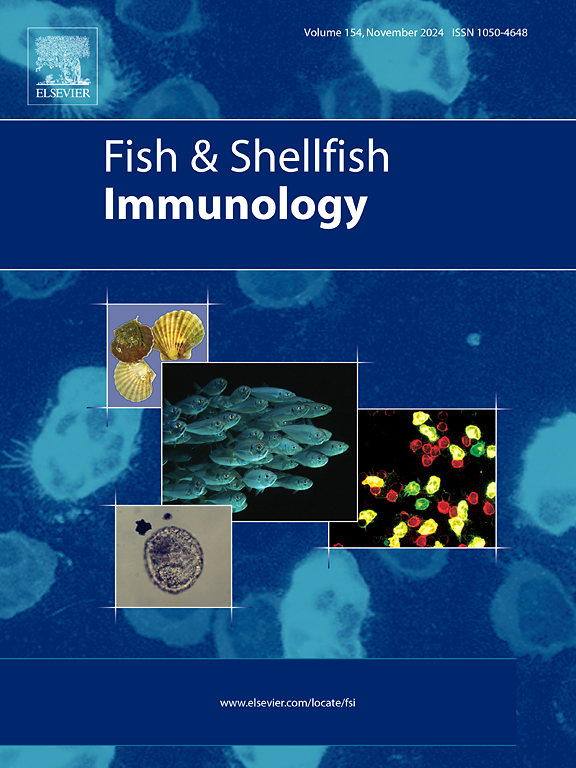Supplementation with Akkermansia muciniphila improved intestinal barrier and immunity in zebrafish (Danio rerio)
IF 4.1
2区 农林科学
Q1 FISHERIES
引用次数: 0
Abstract
Akkermansia muciniphila (Akk), a second-generation probiotic known for its ability to regulate intestinal function in mammals, is not yet fully understood in the context of aquaculture. This study aims to investigate the effects of different forms of Akk on intestinal barrier function and immune response in zebrafish (Danio rerio) under high-fat diet conditions. The experimental groups included a control group, a high-fat diet group, an Akk group, and a group receiving various concentrations of pasteurized Akkermansia muciniphila (P-Akk) along with a high-fat diet. Evaluation methods included histological examination with hematoxylin and eosin staining, ultrastructural analysis using transmission electron microscopy, real-time fluorescence quantitative analysis, and transcriptome sequencing technology. The results showed that both the Akk and P-Akk groups exhibited a significant increase in villi number and length compared to the high-fat group. Furthermore the expression levels of claudin, claudin-2, occludin A, occludin B, and other genes were significantly upregulated, while the expression levels of intestinal proinflammatory factors genes and proteins were significantly downregulated. Compared to the high-fat group, the Akk group showed a more complete and well-preserved nucleus, mitochondria, and tight junction structures. Additionally, the morphology of intestinal epithelial microvilli in the medium and high concentration Akk group was complete and dense. The expressions of tlr2 and nf-κb were upregulated, while the expressions of myd88 and nod2 were downregulated in the medium- and high-concentration Akk groups. Akk may improve immune dysfunction in high-fat fed zebrafish through the TLR2/NF-κB signaling pathway, which requires further study. Transcriptome analysis revealed significant upregulation of the immune-related gene pigr, significant downregulation of stat3, and significant upregulation of the intercellular adhesion molecule f11r. In conclusion, dietary Akk supplementation alleviated intestinal barrier damage and immune dysfunction in high-fat zebrafish. This study provides important insights into the potential use of Akk in fish and lays the foundation for further studies on its role in fish immunity.
补充 Akkermansia muciniphila 可改善斑马鱼(Danio rerio)的肠道屏障和免疫力。
Akkermansia muciniphila(Akk)是一种第二代益生菌,以其调节哺乳动物肠道功能的能力而闻名,但在水产养殖方面尚未得到充分了解。本研究旨在探讨不同形式的 Akk 对高脂饮食条件下斑马鱼(Danio rerio)肠道屏障功能和免疫反应的影响。实验组包括对照组、高脂饮食组、Akk 组,以及接受不同浓度巴氏杀菌Akkermansia muciniphila(P-Akk)和高脂饮食的组。评估方法包括苏木精和伊红染色组织学检查、透射电子显微镜超微结构分析、实时荧光定量分析和转录组测序技术。结果表明,与高脂肪组相比,Akk 组和 P-Akk 组的绒毛数量和长度都有显著增加。此外,claudin、claudin-2、occludin A、occludin B等基因的表达水平显著上调,而肠道促炎因子基因和蛋白的表达水平显著下调。与高脂组相比,Akk 组的细胞核、线粒体和紧密连接结构更为完整和完好。此外,中高浓度 Akk 组的肠上皮微绒毛形态完整而致密。在中浓度和高浓度 Akk 组中,tlr2 和 nf-κb 的表达上调,而 myd88 和 nod2 的表达下调。Akk可能通过TLR2/NF-κB信号通路改善高脂喂养斑马鱼的免疫功能障碍,这需要进一步研究。转录组分析显示,免疫相关基因 pigr 明显上调,stat3 明显下调,细胞间粘附分子 f11r 明显上调。总之,膳食中补充 Akk 可减轻高脂斑马鱼的肠屏障损伤和免疫功能障碍。这项研究为Akk在鱼类中的潜在应用提供了重要见解,并为进一步研究其在鱼类免疫中的作用奠定了基础。
本文章由计算机程序翻译,如有差异,请以英文原文为准。
求助全文
约1分钟内获得全文
求助全文
来源期刊

Fish & shellfish immunology
农林科学-海洋与淡水生物学
CiteScore
7.50
自引率
19.10%
发文量
750
审稿时长
68 days
期刊介绍:
Fish and Shellfish Immunology rapidly publishes high-quality, peer-refereed contributions in the expanding fields of fish and shellfish immunology. It presents studies on the basic mechanisms of both the specific and non-specific defense systems, the cells, tissues, and humoral factors involved, their dependence on environmental and intrinsic factors, response to pathogens, response to vaccination, and applied studies on the development of specific vaccines for use in the aquaculture industry.
 求助内容:
求助内容: 应助结果提醒方式:
应助结果提醒方式:


